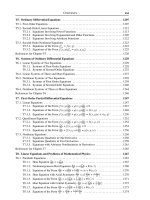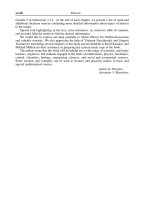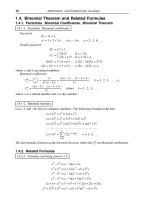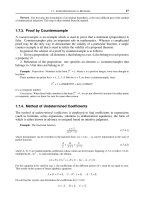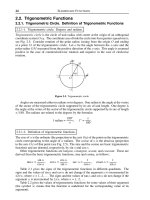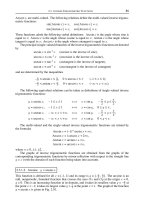Handbook of mathematics for engineers and scienteists part 185 pptx
Bạn đang xem bản rút gọn của tài liệu. Xem và tải ngay bản đầy đủ của tài liệu tại đây (333.65 KB, 7 trang )
1256 FIRST-ORDER PARTIAL DIFFERENTIAL EQUATIONS
9.
∂w
∂x
+
xf(w) + yg(w) + h(w)
∂w
∂y
=0.
General solution: y +
xf(w)+h(w)
g(w)
+
f(w)
g
2
(w)
=exp
g(w)x
Φ(w).
10.
∂w
∂x
+ f(x)g(y)h(w)
∂w
∂y
=0.
General solution:
dy
g(y)
– h(w)
f(x) dx = Φ(w).
T7.2.3. Equations of the Form
∂w
∂x
+ f(x, y, w)
∂w
∂y
= g(x, y, w)
In the solutions of equations T7.2.3.1–T7.2.3.11, Φ(z) is an arbitrary composite function
whose argument z can depend on x, y, and w.
1.
∂w
∂x
+ aw
∂w
∂y
= f (x).
General solution:
y = ax
w – F(x)
+ a
F (x) dx + Φ
w – F(x)
,whereF (x)=
f(x) dx.
2.
∂w
∂x
+ aw
∂w
∂y
= f (y).
General solution:
x =
y
y
0
dz
√
2aF (z)–2au
+ Φ(u), where F (y)=
f(y) dy, u = F (y)–
1
2
aw
2
.
3.
∂w
∂x
+
aw + f(x)
∂w
∂y
= g(x).
General solution:
y = ax
w – G(x)
+ a
G(x) dx + F(x)+Φ
w – G(x)
,
where
F (x)=
f(x) dx, G(x)=
g(x) dx.
4.
∂w
∂x
+ f(w)
∂w
∂y
= g(x).
General solution: y =
x
x
0
f
G(t)–G(x)+w
dt +Φ
w – G(x)
,whereG(x)=
g(x) dx.
T7.2. QUASILINEAR EQUATIONS 1257
5.
∂w
∂x
+ f(w)
∂w
∂y
= g(y).
General solution:
x =
y
y
0
ψ
G(t)–G(y)+F (w)
dt + Φ
F (w)–G(y)
,
where G(y)=
g(y) dy and F (w)=
f(w) dw. The function ψ = ψ(z)isdefined
parametrically by ψ =
1
f(w)
, z = F (w).
6.
∂w
∂x
+ f(w)
∂w
∂y
= g(w).
General solution: y =
f(w)
g(w)
dw + Φ
x –
dw
g(w)
.
7.
∂w
∂x
+
f(w) + g(x)
∂w
∂y
= h(x).
General solution:
y =
x
x
0
f
H(t)–H(x)+w
dt + G(x)+Φ
w – H(x)
,
where
G(x)=
g(x) dx, H(x)=
h(x) dx.
8.
∂w
∂x
+
f(w) + g(x)
∂w
∂y
= h(w).
General solution:
y =
f(w)
h(w)
dw +
w
w
0
g
H(t)–H(w)+x
h(t)
dt + Φ
x – H(w)
,whereH(x)=
dw
h(w)
.
9.
∂w
∂x
+
f(w) + yg(x)
∂w
∂y
= h(x).
General solution:
yG(x)–
G(x)f
H(t)–H(x)+w
dx = Φ
w – H(x)
,
where G(x)=exp
–
g(x) dx
and H(x)=
h(x) dx.
10.
∂w
∂x
+ f(x, w)
∂w
∂y
= g(x).
General solution: y =
x
x
0
f
t, G(t)–G(x)+w
dt+Φ
w–G(x)
,whereG(x)=
g(x) dx.
1258 FIRST-ORDER PARTIAL DIFFERENTIAL EQUATIONS
11.
∂w
∂x
+ f(x, w)
∂w
∂y
= g(w).
General solution: y =
w
w
0
f
G(t)–G(w)+x, t
g(t)
dt+Φ
x–G(w)
,whereG(w)=
dw
g(w)
.
T7.3. Nonlinear Equations
T7.3.1. Equations Quadratic in One Derivative
In this subsection, only complete integrals are presented. In order to construct the
corresponding general solution, one should use the formulas of Subsection 13.2.1.
1.
∂w
∂x
+ a
∂w
∂y
2
= by.
This equation governs the free vertical drop of a point body near the Earth’s surface (y is the
vertical coordinate measured downward, x time, m =
1
2a
the mass of the body, and g = 2ab
the gravitational acceleration).
Complete integral: w =–C
1
x
2a
3b
by + C
1
a
3/2
+ C
2
.
2.
∂w
∂x
+ a
∂w
∂y
2
+ by
2
=0.
This equation governs free oscillations of a point body of mass m = 1/(2a) in an elastic field
with elastic coefficient k = 2b (x is time and y is the displacement from the equilibrium).
Complete integral: w =–C
1
x + C
2
C
1
– by
2
a
dx + C
2
.
3.
∂w
∂x
+ a
∂w
∂y
2
= f (x) + g(y).
Complete integral: w =–C
1
x +
f(x) dx +
g(y)+C
1
a
dy + C
2
.
4.
∂w
∂x
+ a
∂w
∂y
2
= f (x)y + g(x).
Complete integral:
w = ϕ(x)y +
g(x)–aϕ
2
(x)
dx + C
1
,whereϕ(x)=
f(x) dx + C
2
.
5.
∂w
∂x
+ a
∂w
∂y
2
= f (x)w + g(x).
Complete integral:
w = F (x)(C
1
+ C
2
y)+F (x)
g(x)–aC
2
2
F
2
(x)
dx
F (x)
,whereF(x)=exp
f(x) dx
.
T7.3. NONLINEAR EQUATIONS 1259
6.
∂w
∂x
– f(w)
∂w
∂y
2
=0.
Complete integral in implicit form:
f(w) dw = C
2
1
x + C
1
y + C
2
.
7. f
1
(x)
∂w
∂x
+ f
2
(y)
∂w
∂y
2
= g
1
(x) + g
2
(y).
Complete integral: w =
g
1
(x)–C
1
f
1
(x)
dx +
g
2
(y)+C
1
f
2
(y)
dy + C
2
.
8.
∂w
∂x
+ a
∂w
∂y
2
+ b
∂w
∂y
= f (x) + g(y).
Complete integral: w =–C
1
x + C
2
+
f(x) dx –
b
2a
y
1
2a
4ag(y)+b
2
+ 4aC
1
dy.
9.
∂w
∂x
+ a
∂w
∂y
2
+ b
∂w
∂y
= f (x)y + g(x).
Complete integral:
w = ϕ(x)y +
g(x)–aϕ
2
(x)–bϕ(x)
dx + C
1
,whereϕ(x)=
f(x) dx + C
2
.
10.
∂w
∂x
+ a
∂w
∂y
2
+ b
∂w
∂y
= f (x)w + g(x).
Complete integral:
w =(C
1
y+C
2
)F (x)+F (x)
g(x)–aC
2
1
F
2
(x)–bC
1
F (x)
dx
F (x)
, F(x)=exp
f(x) dx
.
T7.3.2. Equations Quadratic in Two Derivatives
1. a
∂w
∂x
2
+ b
∂w
∂y
2
= c.
For a = b,thisisadifferential equation of light rays.
Complete integral: w = C
1
x + C
2
y + C
3
,whereaC
2
1
+ bC
2
2
= c.
An alternative form of the complete integral:
w
2
c
=
(x – C
1
)
2
a
+
(y – C
2
)
2
b
.
2.
∂w
∂x
2
+
∂w
∂y
2
= a –2by.
This equation governs parabolic motion of a point mass in vacuum (the coordinate x is
measured along the Earth’s surface, the coordinate y is measured vertically upward from
the Earth’s surface, and a is the gravitational acceleration).
Complete integral: w = C
1
x
1
3b
(a – C
2
1
– 2by)
3/2
+ C
2
.
1260 FIRST-ORDER PARTIAL DIFFERENTIAL EQUATIONS
3.
∂w
∂x
2
+
∂w
∂y
2
=
a
x
2
+ y
2
+ b.
This equation arises from the solution of the two-body problem in celestial mechanics.
Complete integral:
w =
b +
a
r
–
C
2
1
r
2
dr + C
1
arctan
y
x
+ C
2
,wherer =
x
2
+ y
2
.
4.
∂w
∂x
2
+
∂w
∂y
2
= f (x).
Complete integral: w = C
1
y + C
2
f(x)–C
2
1
dx.
5.
∂w
∂x
2
+
∂w
∂y
2
= f (x) + g(y).
Complete integral: w =
f(x)+C
1
dx
g
2
(y)–C
1
dy + C
2
. The signs before
each of the integrals can be chosen independently of each other.
6.
∂w
∂x
2
+
∂w
∂y
2
= f (x
2
+ y
2
).
Hamilton’s equation for the plane motion of a point mass under the action of a central force.
Complete integral:
w = C
1
arctan
x
y
+ C
2
1
2
zf(z)–C
2
1
dz
z
, z = x
2
+ y
2
.
7.
∂w
∂x
2
+
∂w
∂y
2
= f (w).
Complete integral in implicit form:
dw
f(w)
=
(x + C
1
)
2
+(y + C
2
)
2
.
8.
∂w
∂x
2
+
1
x
2
∂w
∂y
2
= f (x).
This equation governs the plane motion of a point mass in a central force field, with x and y
being polar coordinates.
Complete integral: w = C
1
y
f(x)–
C
2
1
x
2
dx + C
2
.
9.
∂w
∂x
2
+ f(x)
∂w
∂y
2
= g(x).
Complete integral: w = C
1
y + C
2
+
g(x)–C
2
1
f(x) dx.
T7.3. NONLINEAR EQUATIONS 1261
10.
∂w
∂x
2
+ f(y)
∂w
∂y
2
= g(y).
Complete integral: w = C
1
x + C
2
+
g(y)–C
2
1
f(y)
dy.
11.
∂w
∂x
2
+ f(w)
∂w
∂y
2
= g(w).
Complete integral in implicit form:
C
2
1
+ C
2
2
f(w)
g(w)
dw = C
1
x + C
2
y + C
3
.
One of the constants C
1
or C
2
can be set equal to 1.
12. f
1
(x)
∂w
∂x
2
+ f
2
(y)
∂w
∂y
2
= g
1
(x) + g
2
(y).
A separable equation. This equation is encountered in differential geometry in studying
geodesic lines of Liouville surfaces. Complete integral:
w =
g
1
(x)+C
1
f
1
(x)
dx
g
2
(y)–C
1
f
2
(y)
dy + C
2
.
The signs before each of the integrals can be chosen independently of each other.
T7.3.3. Equations with Arbitrary Nonlinearities in Derivatives
1.
∂w
∂x
+ f
∂w
∂y
=0.
This equation is encountered in optimal control and differential games.
1
◦
. Complete integral: w = C
1
y – f(C
1
)x + C
2
.
2
◦
. On differentiating the equation with respect to y, we arrive at a quasilinear equation of
the form T7.2.2.3:
∂u
∂x
+ f
(u)
∂u
∂y
= 0, u =
∂w
∂y
,
which is discussed in detail in Subsection 13.1.3.
3
◦
. The solution of the Cauchy problem with the initial condition w(0, y)=ϕ(y) can be
written in parametric form as
y = f
(ζ)x + ξ, w =
ζf
(ζ)–f (ζ)
x + ϕ(ξ), where ζ = ϕ
(ξ).
See also Examples 1 and 2 in Subsection 13.2.3.
2.
∂w
∂x
+ f
∂w
∂y
= g(x).
Complete integral: w = C
1
y – f(C
1
)x +
g(x) dx + C
2
.
1262 FIRST-ORDER PARTIAL DIFFERENTIAL EQUATIONS
3.
∂w
∂x
+ f
∂w
∂y
= g(x)y + h(x).
Complete integral:
w = ϕ(x)y +
h(x)–f
ϕ(x)
dx + C
1
,whereϕ(x)=
g(x) dx + C
2
.
4.
∂w
∂x
+ f
∂w
∂y
= g(x)w + h(x).
Complete integral:
w =(C
1
y + C
2
)ϕ(x)+ϕ(x)
h(x)–f(C
1
ϕ(x))
dx
ϕ(x)
,whereϕ(x)=exp
g(x) dx
.
5.
∂w
∂x
– F
x,
∂w
∂y
=0.
Complete integral: w =
F (x, C
1
) dx + C
1
y + C
2
.
6.
∂w
∂x
+ F
x,
∂w
∂y
= aw.
Complete integral: w = e
ax
(C
1
y + C
2
)–e
ax
e
–ax
F (x, C
1
e
ax
) dx.
7.
∂w
∂x
+ F
x,
∂w
∂y
= g(x)w.
Complete integral:
w = ϕ(x)(C
1
y + C
2
)–ϕ(x)
F
x, C
1
ϕ(x)
dx
ϕ(x)
,whereϕ(x)=exp
g(x) dx
.
8. F
∂w
∂x
,
∂w
∂y
=0.
Complete integral:
w = C
1
x + C
2
y + C
3
,
where C
1
and C
3
are arbitrary constants and the constant C
2
is related toC
1
by F (C
1
, C
2
)=0.
9. w = x
∂w
∂x
+ y
∂w
∂y
+ F
∂w
∂x
,
∂w
∂y
.
Clairaut’s equation. Complete integral: w = C
1
x + C
2
y + F (C
1
, C
2
).



